How does my hair colour affect my colour analysis?
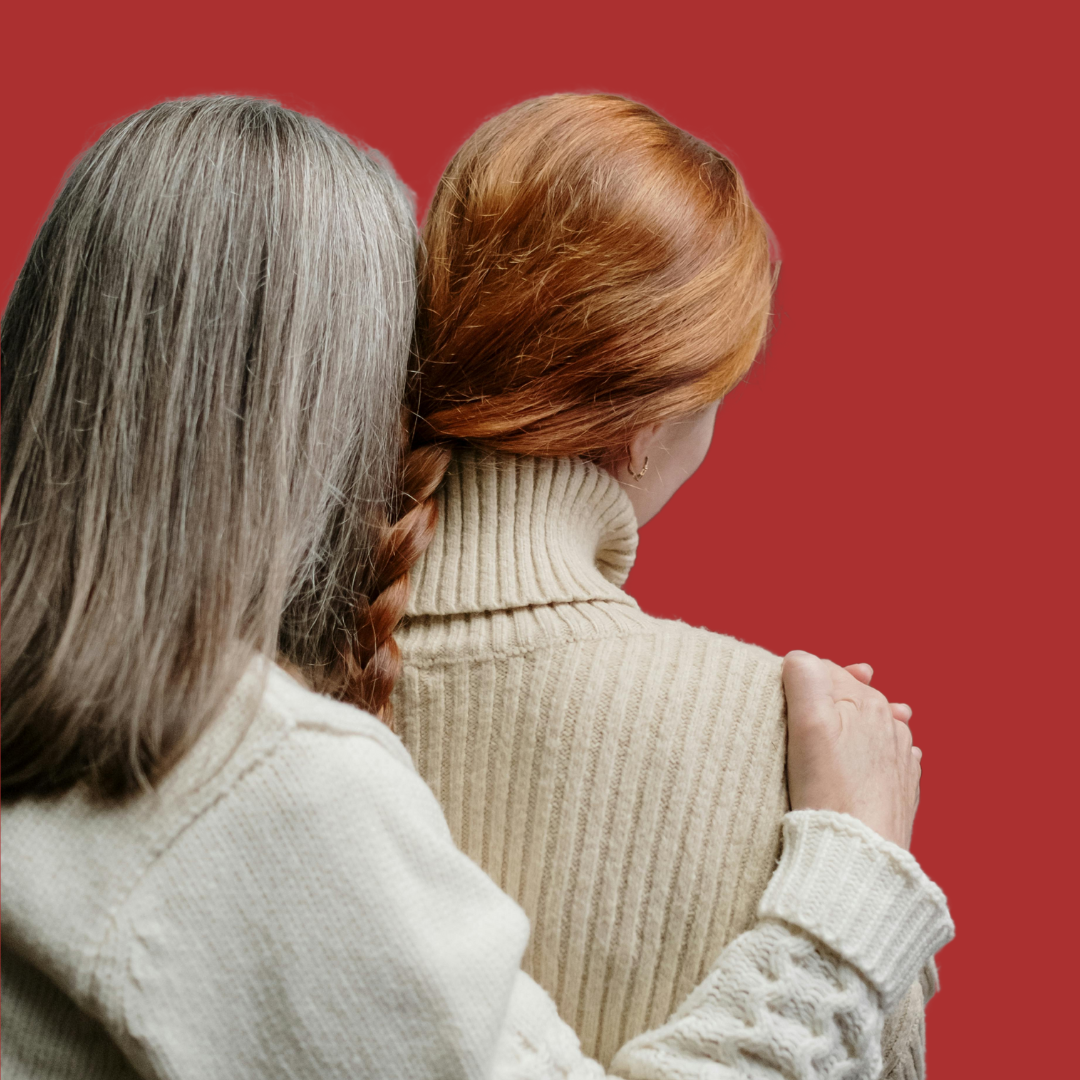
Hair colour; it’s a conundrum. To embrace grey or not, to enter (and remain on) that hair dye treadmill or not, to choose a single colour for life or to embrace every hair trend from lowlights to balayage?
And when you factor in colourful clothes, those questions multiply - suddenly there feels like much more to think about, harmonise, and match! But don’t give in to temptation to sink back into those ‘safe’ neutrals (and as you’ll learn when you begin to explore the world of colour, even choosing the right neutrals can put a new spring in your step!).
Instead, why not discover the answers to every question you’ve ever had about how hair colour relates the colours you wear, and whether that changes when your hair colour does?
Whether your questions are about going grey, colouring your hair, matching your hair to your colour palette (or vice versa), or how to wear colour that harmonises with your hair,, we’ve answered them all here so you can get back to the important work of wearing colour with confidence, joy and panache, knowing that you look every bit as fabulous as you feel!
Before you start: this article is a truly in depth look at hair colour and going grey. We recommend you make yourself comfortable and settle in for a good read! If you’re in a hurry, you might prefer to click on one of these links to go straight to one of the questions we answer:
1. How is my hair related to the colours that suit me?
2. Does altering my hair colour affect my palette?
3. Can my natural hair colour be 'wrong' for my palette?
5. I've dyed my hair for years, how do I go about transitioning to grey?
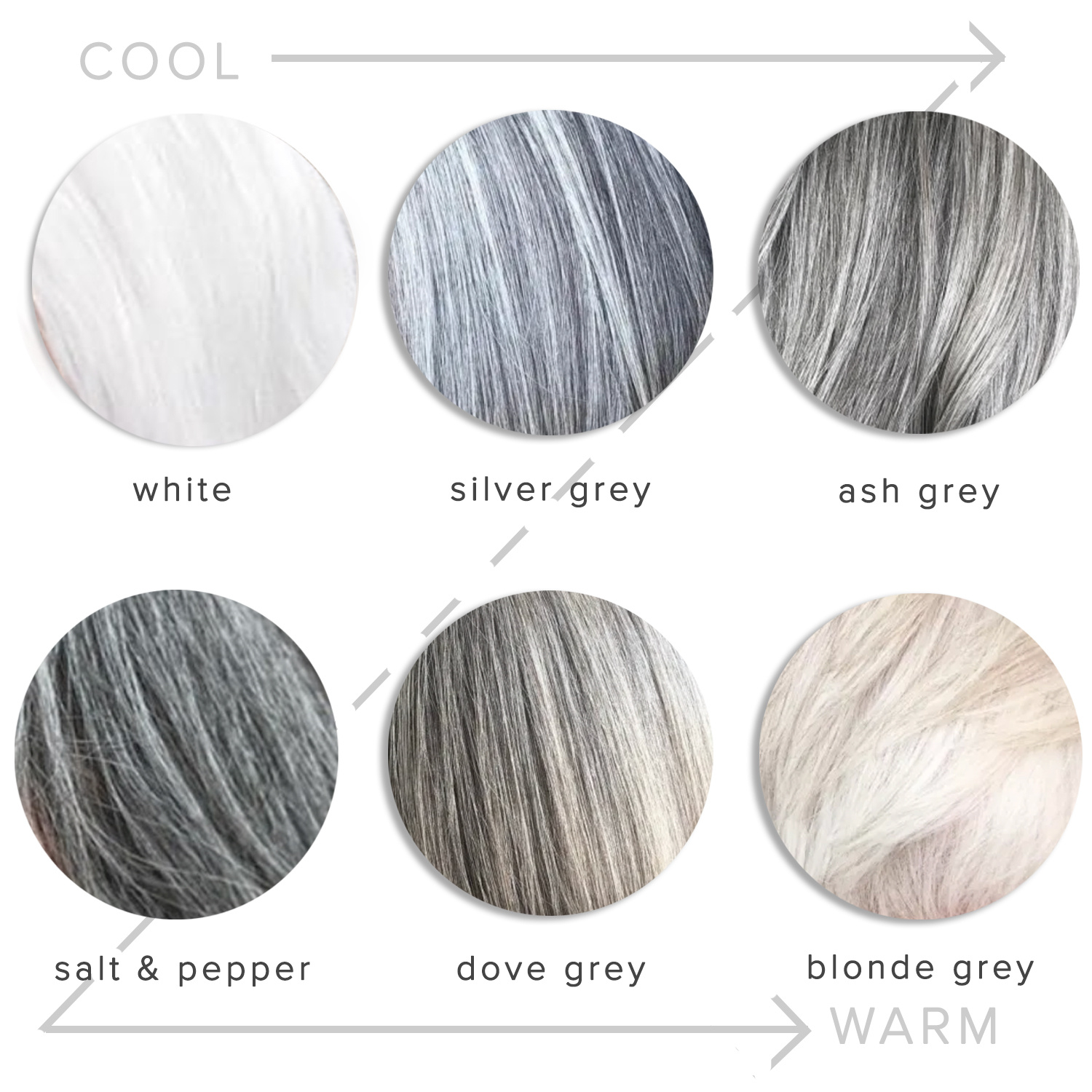
1. How is my hair related to the colours that suit me?
Before we get stuck into changes to hair colour, it’s important to consider the role your hair colour plays in the palette of colours that best suits you.
Put simply, each of us has a palette of colours that belongs to us. Your own palette is made up of colours that reflect the natural level of warmth, vibrancy and contrast that you carry, and when you wear it (either as clothes, make or, yes, hair colour!) will make you feel more alive, put together, in harmony and confident, and that, as an extra bonus, mix and match endlessly to make beautiful outfits, giving you a harder working wardrobe and all but eliminating mistake purchases.
Here at Kettlewell, to help you find the right colours for you, we divide colours up into four distinct palettes, each one named after a season. It’s possible to get even more specific about which colours are best for you than simply a quarter of all colours, but this is a really good starting point for most people, and you can choose whether or not to dive further into the kaleidoscopic rabbit hole of colour once you’ve been introduced to your own seasonal palette.
The group of colours that belongs to you - which will be named after one of the four seasons, Spring, Summer, Autumn and Winter - is defined by your natural colouring. This means not only your skintone, but also your eye colour, lip colour and, you guessed it, natural hair colour. At a basic genetic level, these elements have been created in the harmony that Mother Nature so excels at, from a cohesive palette of colours that comes together to make the miracle that is you!
Whenever you add additional colours to your natural look, either through the act of wearing clothes or through adding colour with make up or hair dye, this has an impact on that natural harmony in one of two ways:
1. It enhances it. Your eyes become brighter, your skin glows and, most importantly of all, you feel better, wearing clothes that naturally belong to you and enhancing everything that makes you you.
2. It detracts from it. Your skin looks excessively pale, flushed or sallow, your eye colour appears less bright, and you feel flat, underwhelmed and invisible.
Obviously, we believe that the former is far preferable to the latter, and we believe that everyone should feel confident and boosted, not diminished, by their clothing and colour choices. This just as, if not more, important when it comes to hair colour - after all, your hair is the one thing you wear every day!
Remember, your hair will naturally always harmonise with your palette (we’ll discuss the impact going grey might have further through this article), but let’s consider for a moment the impact of dyeing your hair, whether that’s to cover grey or not.
2. Does altering my hair colour affect my palette?
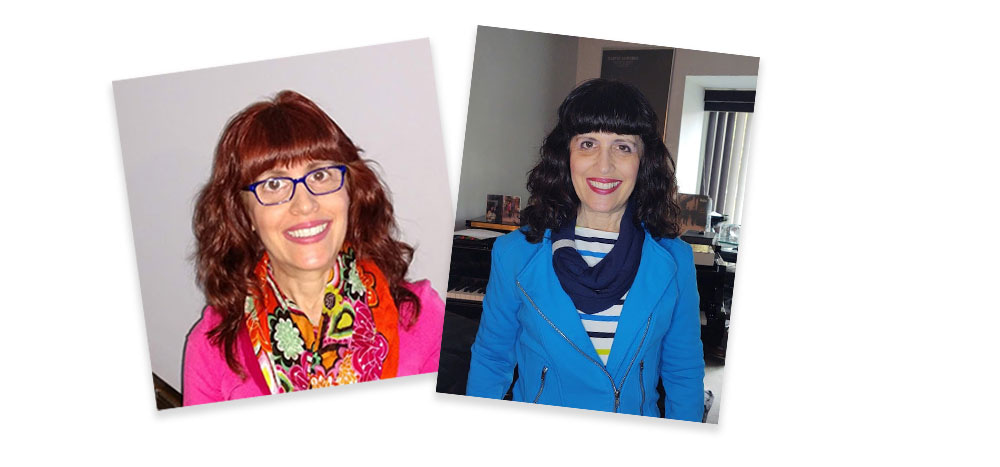
Above: Eileen discovered that her warm red hair was less flattering against her cool skin tone than her natural dark brown.
Once you understand that the colours you add to your look impact on how good you feel (and look!), the impact of changing your hair colour is suddenly highlighted. So does changing your hair colour (whether that’s covering grey or not) affect the colours that best suit you, and how should you balance hair and clothing colours?
The short answer is that your palette is your palette. Changing your hair colour won’t alter everything else about you - skintone, eyes, brows, lips etc - so your overall palette will remain the same. However, that new hair colour might throw an additional colour into the mix that you now need to consider when choosing which colours to wear on your body.
Here at Kettlewell we think life in colour (and even in neutrals!) is easier when you choose your hair colours to harmonise with your seasonal colour palette. This means that not only will there will never be a battle between the hair colour you’ve chosen and your seasonal colour palette, but your hair colour will actually support and even enhance your natural colouring, making you look and feel as amazing as wearing your favourite colour clothing does.
So what does that actually mean? The first step is obviously to discover which seasonal palette belongs to you. If you don’t know this, now might be a good moment to head over to our clever Colour Quiz and discover your palette, then come back here to discover the hair colours that will work for you. A good colourist will work with your natural colouring anyway, but having some language to communicate with them about the best colours for you can ensure that you are all on the same page when it comes to the all important task of colouring your hair.
Spring hair colours
Opt for warm tones, filled with lightness and radiance. Sunkissed, golden, honey, caramel and champagne colours are often excellent, and browns stay warm and golden feeling, never too dark. Strawberry blonde and red can also work well. Greys stay warm, more like a pale gold than anything remotely blue.

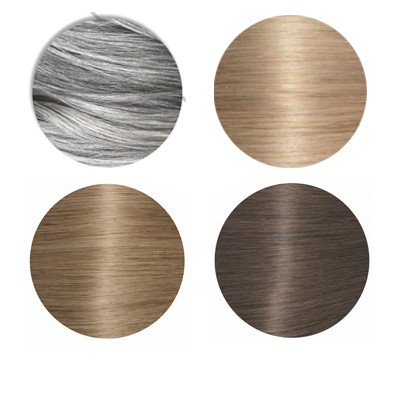
Summer hair colours
Choose cool tones, with tonal blends of colour - highlights, balayage and other techniques for layering colour all work really well. Ash brown, icy blonde, mushroom tones, and even inky bluish tints to grey can work well. The key is to avoid anything brassy, although interestingly a red colour can sometimes work - never go too warm with this, instead opting for tints of burgundy or cherry. Grey is always cool, from steel grey through to white, and is can be supported with dye or simply a shampoo designed to eliminate blonde or brassy tones.
Autumn hair colours
Your best colours are warm tones, filled with depth and layers of colour. Again, balayage and deep lowlights can be really effective to get that feeling of layered up colours. Chocolate, deep caramel and toffee, rich auburn reds and deep blonde tones all work, but try to avoid going too light or insipid feeling with colours. Grey is usually naturally warm, and it’s usually best to embrace and even enhance this rather than trying to cool things down with blue tones.
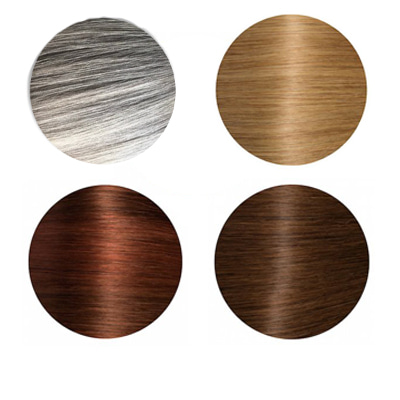
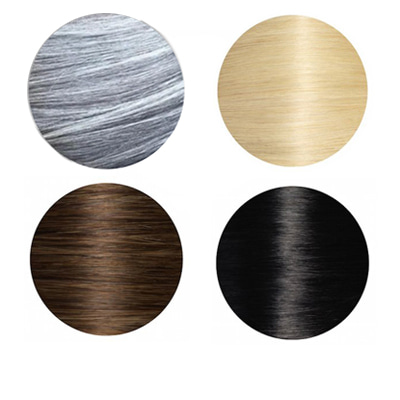
Winter hair colours
Choose cool tones, with a clear, definite look - no layers of gently textured highlights here, but rather block colour or definite ‘slices’ of colour through the hair, rather than tiny slivers of several shades. Think clear, crisp and defined when it comes to colours. Extremes like darkest brown or black, or ash blonde through to icy peroxide, can work well, but don’t feel the need to change mid-tone hair if that’s where you naturally sit. Grey is steel through to crisp blue-toned white.
All this is well and good, but there might be times when, intentionally or otherwise, your hair simply doesn’t harmonise with your seasonal palette. Maybe you or your hairdresser chose a slightly different tone to usual, maybe you simply fancied a change, maybe the sun or your shampoo has shifted the tone of your hair and pulled it ‘out’ of your palette. What happens then?
The key here is to remember that every other aspect of your colouring - your skintone, eyes and lips - still sit within your palette, it’s only your hair that will be altered when you colour it. So the core components of your colouring haven’t changed; it’s simply that we’ve introduced an additional shade that needs to be allowed for when choosing colours for outfits, in order to ensure you still feel like the truest version of you.
Shifting the colours you choose might be as simple as, say, playing up different tones within your palette to harmonise with your new hair colour without sacrificing your best colours. For instance, if you’re a Spring who usually opts for warm Honey and Corn Yellow in clothing, who then has a blue (cool) tint added to grey hair, you might find that you can honour that simply by slipping into the blues from your palette, like Aqua, Cornflower and Bright Navy, rather than by diving into super cool toned French Blue, Sapphire or Indigo.
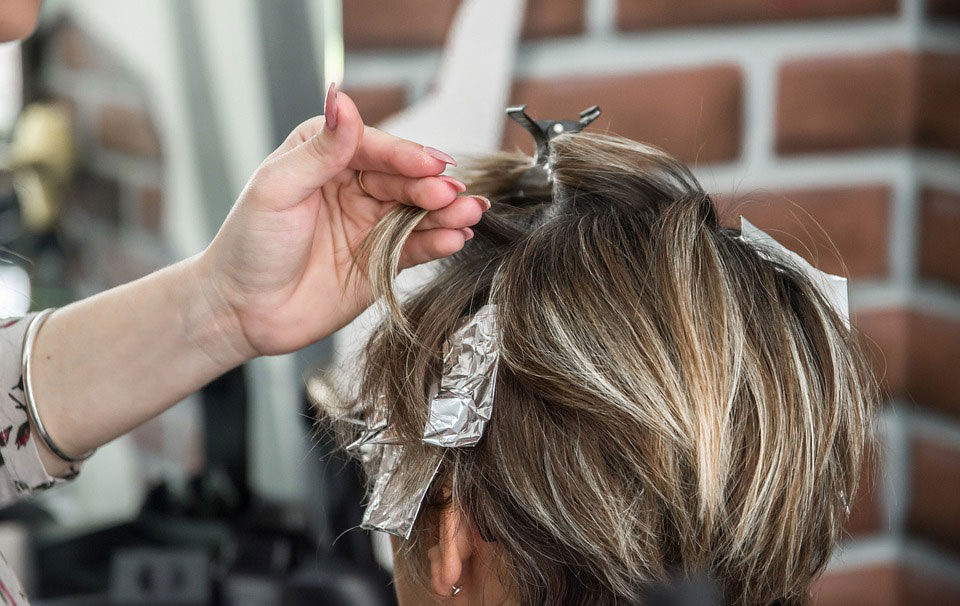
3. Can my natural hair colour be ‘wrong’ for my palette?
Let’s be clear here: dyeing your hair is always optional. Nobody has the right to tell you that you ‘shouldn’t’ be grey (or brown, or blonde, or red) at any age or stage of life.
Added to this, your best palette will always work with your natural hair colour. Which isn’t to say that adding a splash of colour can’t make you enjoy both your hair and your colours even more (we’re definitely not anti-dye here!), but remember that your natural hair colour, whether it’s as true and vibrant as it was in your teenage years or has faded to almost white, is always going to be in harmony with your palette. That harmony might mean a slight shift within your palette - read on to find out how that might work for you.
Aside from going grey, you might feel that your natural hair, even if not grey, isn’t ‘right’ for your season (sandy haired Winters and red headed Summers, for instance, are often concerned that they need to dye their hair to match their season). But it’s exactly the same story; nature will always create your own natural palette to be in harmony, and your natural palette will always work with your colours.
4. What about when I go grey? Do I need to cover greys for my colours to work, or do my best colours change?
Hair goes grey. It’s a fact of life, but one that the entire beauty industry would like to pretend happens only to an unlucky few, and should therefore be hidden from sight as far as possible, lest someone realise that we are no longer 23! Of course, this is entirely untrue, but it is a societal mindset that is only now beginning to shift, largely after the pandemic forced many of us to forego trips to the hairdresser for months on end.
But before you worry about whether or not you should be doing anything about that grey hair, and how to go about doing it in a way that will make you feel fabulous rather than fake, let’s first consider whether embracing that natural grey hair means that your best colours will suddenly shift dramatically, or whether you can continue to wear exactly the same clothes as before.
The good news is that your hair is not, after a lifetime of service, suddenly going to turn against you and your natural palette, simply because you’ve gone grey. It is just not how our natural colouring works. As we go grey, we lose some pigment from our hair (and also from our eyes, lips and cheeks - the brightness of youth comes so much from that extra pigment!), but the pigment that remains doesn’t suddenly shift from being warm toned to being cool, or vice versa.
You might notice that if you are a warm toned season (Spring or Autumn) or dominant Warm, that as you go grey your hair retains a slightly warm, creamy tone. Whereas the cool toned seasons (Summer and Winter) and Cool dominants tend to naturally veer towards a much steelier grey, or pure white. Whichever you are, your hair will harmonise with your palette, although remember that your best colours within your palette might shift as your hair gets lighter.
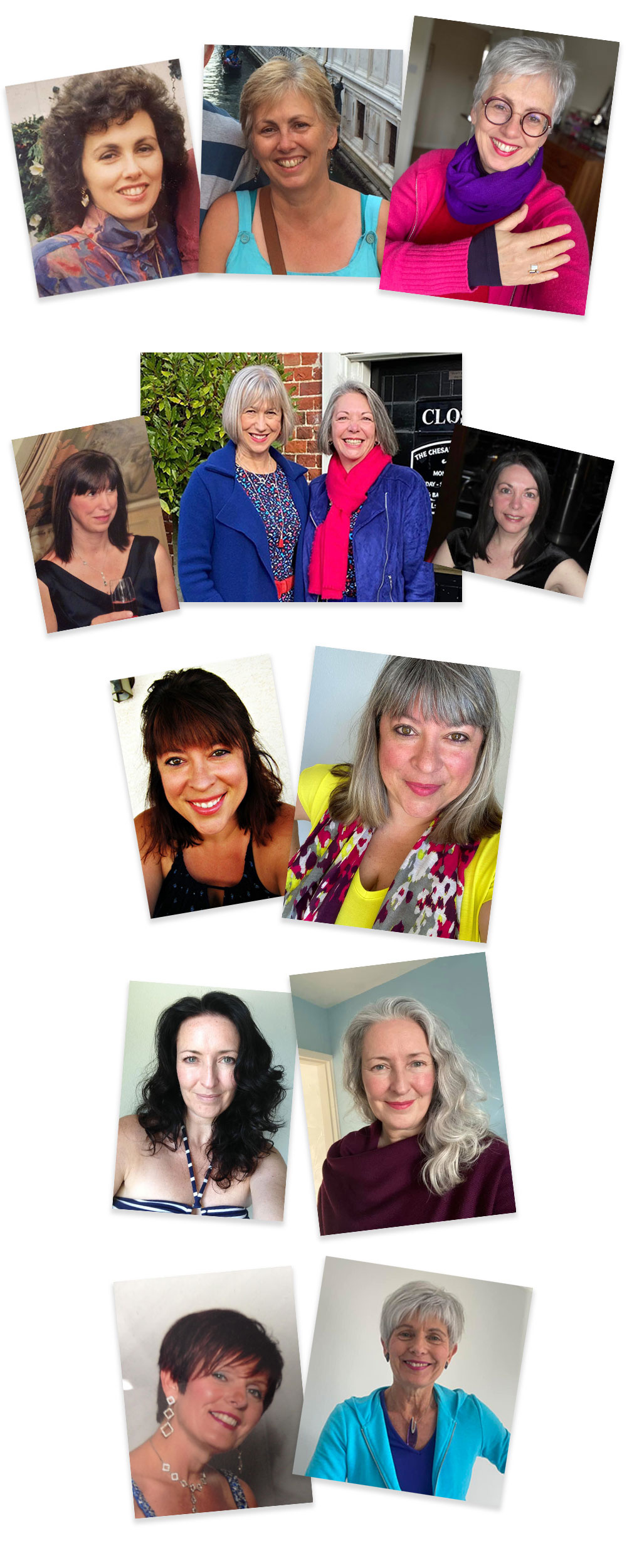
Above: Colour Club members share photos from before they embraced the grey
If you’re going grey you might, however, feel like you’ve lost some of the ‘oomph’ from your colouring and thus your look, thanks to this drop in pigment. You might also find that colours that you’ve previously loved feel either overwhelming or, surprisingly, not ‘enough’ to brighten you up.
However, what we’ve found, over almost 20 years of working in the world of colour, is that it’s extremely unlikely that your actual seasonal palette will change - if you’ve hitherto suited the Spring palette you’re not going to suddenly become a Winter because you’ve gone grey, for all the reasons discussed above. However, it is possible your very best colours (often called your wow colours - most of us half half a dozen or so truly amazing colours) within that seasonal palette may well shift. You might need, say, brighter colours within your season, but it is almost certain (indeed, in our experience, guaranteed) that your broad palette will remain the same.
Let’s take a quick look at how the colours you need might change, depending on your seasonal palette. It’s impossible to predict exactly how your unique colouring will shift with age, but there are a few general guidelines which inform each palette, and probably make a good starting point if your hair colour has shifted and you feel your favourite colours are no longer looking quite as good.
Grey haired Springs - It is very possible that if you have generally been at the warmer end of the Spring palette (wearing camel, honey, tan and chocolate as your neutrals, and Spring’s Corn Yellow, Lime Green and Papaya as your brights), that you will shift towards the less warm end of the palette, meaning that your neutrals will become Bright Navy and Dove Grey, while your brights might become Confetti pink, Apple green and Aquarius. If you’ve previously suited the brightest colours in your palette, whether warmer or cooler, it’s possible that some of the softer Spring colours - Cornflower, Lemonade, Hyacinth - might now be better on you than those bold brights.


‘I was first typed as Spring back in the 1970’s when I was a golden blonde. My hair darkened after children to what I’d call dirty blonde. As my children became teens, my hair turned gray and now in my 70’s it is mainly white with some blonde tones. I was reclassified as a Light Spring in 2018.’ - Gail
As a romantic, I obviously call my hair silver sparkle not grey!’ - Helen
Grey haired Summers - If you’ve previously worn the deepest Summer colours, from Burgundy to Charcoal, you might find yourself needing at least a splash of lighter tones like Pink Ice or French Blue to lift outfits that previously worked well. If you’ve always worn the softest, palest Summer colours, you might, counter-intuitively, find that brighter Summer colours like Cornflower and Azalea Pink now bring you more to life.


‘I was very nervous about growing out my grey to start with and friends were a bit negative, but now it's done I've never had so many compliments and my "negative” friends are converted.’ - Jennifer
‘Since going grey, I tend to choose lighter versions of my Summer palette, and often combine them with cool grey shades, which I never wore previously. My natural silver-grey hair is now in harmony with my cool skin and eyes.’ - Sue
Grey haired Autumns - Many Autumns, regardless of their original type, find that they need softer colours within the palette as they go grey. Whether you suit the warmer soft colours - Hazelnut and Coral Haze, for instance - or less warm Heliotrope and Lizard Grey, is a matter for discovery! However, some Autumns do find that they suddenly need the lightest, brightest Autumn colours, like Coral and Lime, to feel their glowing best.


‘‘Do I regret all those years of colouring my hair? No. Do I regret my decision now to go grey? No. I think you know when you are ready. It isn’t for everyone and I never thought it would be me. I’m looking forward now to continuing to wear my colours from my bright autumn palette (and, no, I haven't changed to a cool season because my hair is grey).’ - Sue
'I embraced my gray at age 43 (six years ago). I have not regretted it — I get compliments on it daily about how shiny & healthy it looks — especially now that I know what colors to wear!'- Cindi
Grey haired Winters - the most common shift for Winters is that the old faithful neutrals of Black and White stop working so well, and gentler Navy and Silver (or Ice Blue) work better. You might also find that where you used to suit the deepest, most intense Winter colours like Pine, Deep Claret and Indigo, you now need much fresh, clearer alternatives like Emerald and Scarlet. You might also find that previously unloved, and less cool, light Winter colours like Acid Yellow, Limeade and Aquarius, are suddenly invaluable for giving you back your brightness and zing!


'Going grey was a big thing for me, and once I’d done it I really felt like I’d ‘come home’ and was comfortable as a winter again. When I had my hair coloured, I looked like an autumn and wore a lot of autumn colours, but there was a terrible dissonance. Of course, for me, and probably for everyone else, the other important issue is to have a really good hair cut to show off the grey.’ - Alex
‘It was a big decision for me to let my hair go natural, and I needed advice along the way’ - Kellee
Side note: There are some analysis systems that will assign you an entirely new palette if you go grey or have any other significant hair colour change. In our experiences, this is because the initial palette they have assigned you is a more specific, narrower range of colours than a full seasonal palette (for instance, Colour Me Beautiful has 24 possible palettes, compared to the four seasonal ones), so it makes sense that a fresh palette might be required if colouring changes, as the original palette was more fine tuned to your colouring. We believe that there are pros and cons of both seasonal and 12, 16 and 24 palette systems, and it’s generally much more about finding a palette (and a stylist, if you use one) that you understand and that feels right for you, than it is about one system being ‘better’ than another.
5. I’ve dyed my hair for years, how do I go about transitioning to grey?
If you are transitioning from dyed hair to grey, the options are broadly similar regardless of your seasonal palette:
1. Go cold turkey on the dye. You might want to get existing colour stripped out, but this can be quite harsh on your hair, and will do nothing to alter bleached hair. There will be an undeniably awkward phase as your dye grows out, but this is the most straightforward way to transition to grey, if you can plough through the awkward bit.
2. Have your hair dyed a similar shade of grey to your natural root colour. This will take some careful co-ordination with your hairdresser in order to select an appropriate shade, but it’s a one hit way of making the transition, and the delineation between your dyed grey and naturally grey hair should be far less awkward than option 1. It is, however, quite a sudden change to get your head around!
3. Go for a gradual approach. Gradually have a few lighter touches added to your colour, reducing the amount of tone in them at each appointment, to gradually blend your grey with your existing dye colour. Even for Winters, who tend not to suit blended, tonal colours, this can be the easiest, gentlest and least scary way to transition hair, although it also takes the longest.
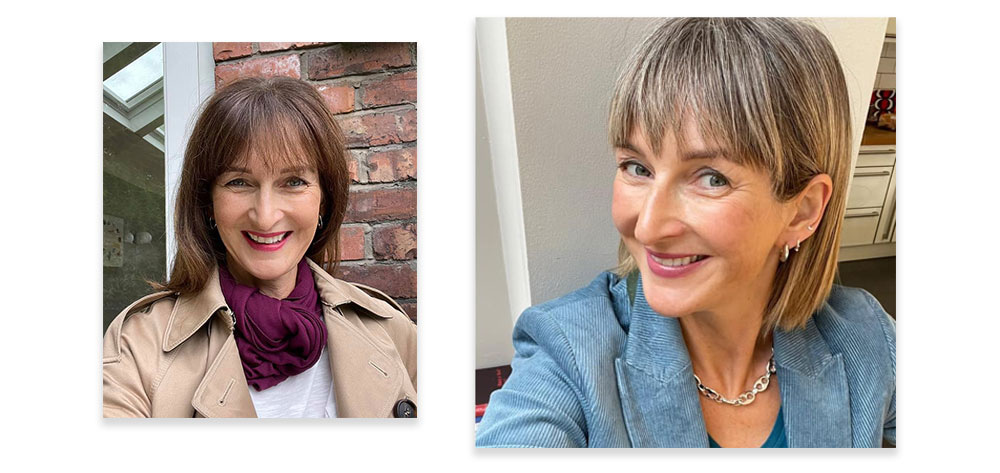
Colour stylist Karina demonstrates the gradual approach to going grey
Whatever option you choose, a good hairdresser is invaluable to help you figure out your next steps and encourage you along the way. And a good cut, which feels like it belongs to you, can work wonders to boost your confidence while you’re getting used to a different look.
The one other question that seems to crop up is ‘will I look older if I leave my hair its natural shade’? Once upon a time, this definitely felt true – everyone dyed their hair, so leaving it to go grey made one stand out as an ‘older’ looking person. These days, there is such a mix of those who dye and those who go au naturel, and even younger people choosing to dye their hair grey, that such a definitive statement is no longer the case. I also believe (or hope!) that the world is somewhat less ‘age-phobic’ than it has been in the past – we are allowed to celebrate the wisdom and experience that age gives us, rather than trying to hide and reverse the process.
One final note on the hair itself – grey hair is often more coarse and more dry, and needs specific care – looking after your greys with appropriate haircare will give them a glow all of their own.
6. Do I need to change my make up to suit my hair colour?
As we age, our skin loses not only elasticity, but also contrast and pigment in our lips, cheeks and eyes. This means that regardless of your hair colour, if you haven’t reassessed your make up for a few years, now might be a good time. Areas that you used to be able to skip without a problem - brows and cheeks, for instance - now need a little more attention, and darker colours that you used to wear with confidence might now feel a little heavy or strong.
This question really gets the same answer as the question about changing your clothing colours to suit grey hair. You might find that the make up colours that you used to wear now feel too strong, or too dark, but the best colours to replace them with will likely be softer, or perhaps lighter and clearer, versions of the same colours, sticking within your seasonal palette.
The best thing you can do for your colour confidence is to treat shifting your make up colours as an adventure in the same way as discovering your seasonal colour palette. You might want to check out Look Fabulous Forever - a range of makeup and skincare created specifically for older women by Tricia Cusden (who looks fabulous with her grey hair!). Her Youtube channel is full of helpful tips and tutorials.
Above: Tricia Cusden with some of her Look Fabulous Forever make-up range
In conclusion
I hope that this article has answered all of your questions, and that you feel encouraged you to see going grey as an adventure and a chance to explore and learn more about your best colours. This is the beginning of an era, not the end of one.
If you want more inspiration, or advice, from women going through the same journey as you, why not come and join our friendly Colour Club on Facebook? We’ve used member images to illustrate this article, and advice and support, whatever your colour journey and choices, is guaranteed!

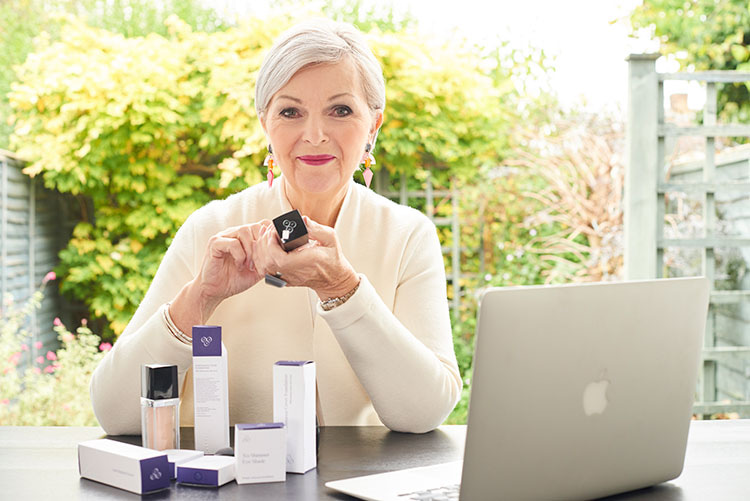

Lisa Conlan on Mar 03, 2024 8:33 AM
Auch a great article! The photos are sooo inspiring too! Everyone looks wonderful 🥰
Has KW ever thought of making a book of these blogs and photos etc?
Carol DuPont on Nov 12, 2023 1:20 AM
New to Kettlewell and what a post! Exceptional integration of the trials and tribulations of embracing the spectrum of grey hair. This year I told my stylist that it was time. I started turning grey @19. I was mortified, so I started highlighting and then every shade of blonde. I had short hair, long hair and going for a cut and color every 6 weeks was expensive. She asked me to grow my hair out at least 4" so she could see what she was working with which was white as snow.
Please follow Jack Martin "@jackmartincolorist" He's the master of grey transformations and a genius!
Trisha on Jul 31, 2023 4:46 PM
I am 70 in 6 months time, but have no intention of going grey! I have changed colour though, within the autumn spectrum. I was naturally very dark brown, with darkest olive eyes and pale, neutral warm skin. I always thought I was a winter, but got typed as a deep autumn several times, so wore those colours for many years. At 50 + I started to go slightly lighter and warmer as the grey came through and my eyes had changed colour to bright, warm green. I got retyped as a warm autumn. I am transitioning at the moment to soft autumn colours though and a lot lighter, slightly warm brown hair colour. My eyes are still green, but liighter and with a lot of grey in them rather than brown flecks, so much softer too. I still have very thick darkest brown eyebrows and eye lashes though and plenty of thick, wavy hair!
Jackie on Jun 16, 2023 8:07 PM
I agree with Rebecca, and have been root-touching and coloring my hair for 30 years, I like the deep brown and at 61 am not ready to go gray. The comment about adding to your makeup routine is what I would have to do as well to not look so washed out when I choose to go gray. Despite the time and inconvenience of frequently " doing" my own hair, I will continue to do it, I will know when I am ready. These women look lovely, but I am not ready for that transition yet.
Melissa on Jan 27, 2023 5:19 PM
BTW, the Roxie in the top picture is the color I missed out on and have been dreaming about. Swedish Blue, right? Please think about doing more items in Swedish Blue.. such a gorgeous color for redheaded Blue Springs! :)
Melissa on Jan 27, 2023 5:16 PM
My personal experience: Nature gives us our very best color. I naturally have light/medium strawberry blond hair. Not really red but in the daylight, definitely warm and golden red. When I went through a phase of wanting my hair balayaged (Really, a soft autumn color) the HoC palette did not look the best on me and so I always questioned if I was typed correctly. Once I embraced my natural color everything else harmonized.
Rebecca Saffer on Jan 21, 2023 6:24 PM
Interesting article but definitely geared towards those “embracing “ the grey. I think deeper brown suits me well and I have no intention of going grey. Good read though.
Barbara on Jan 21, 2023 1:48 PM
I am a big fan of Look Fabulous Forever.
Barbara on Jan 21, 2023 1:44 PM
Really interesting. I am an Autumn and have been highlighting my mid brown hair for some years. In recent years I have thought that this is a good way to transition to grey but as I approach my 70th birthday I am only completely grey at the temples. Going grey is a very slow process in my case.
Laurie on Jan 21, 2023 12:55 PM
Thank you for this article! As a blue autumn with salt and pepper colored hair, I have often felt that my hair was too cool for my autumn pallet. When I had my color analysis 2 years ago, my consultant told me that your natural color is always correct. Your graphic showing that salt and pepper hair is on the warm spectrum beautifully explains this for me!
Sacha on Jan 21, 2023 1:31 AM
Great article! Having been a colour enthusiast for almost 30 years, I’ve seen snippets of all these aspects of the grey/dyed hair/colour palette debate before.
I’m aware that my own journey towards grey hair is not one I plan to take any time soon, and even if it were, it would be a different experience to what you describe above! But then my kind of hair journey is really very unusual for my age (for those reading this who don’t know me - I’m in my late 40s and my hair generally matches my spring colour palette in all the bright, vibrant ways, not the natural hair colour ways).
Nevertheless I’m really pleased to see you covered the issues in so much depth. It is such a big deal and to say less would not have been enough! Maybe one day in the future you might decide to write a more niche blog post - about the less natural ways in which your hair can complement your seasonal palette ;-)
Cathy Stone on Jan 20, 2023 9:39 PM
Great blog. I've been going grey since age 29. But as a very dark-haired winter, I've been colouring it my natural dark brown since then (I'm about to be 60). I work with mostly 20-somethings, and whilst I would like to spend less time and money at the hairdresser's, I think I need to keep colouring while I'm still working. I also think that with short curls that look like an old-fashioned perm, I might look like a little old lady if I went grey! I'm actually looking forward to trying it out, but I've decided not until I retire, whenever that is. I remember when my lovely mum stopped dyeing her very similar hair, and she suddenly looked like a little old lady, bless her!
Alice Readman on Jan 20, 2023 4:19 PM
Very informative
HELEN Turnpenny on Jan 20, 2023 3:21 PM
Your take on this is so interesting - as an ecperienced consultant I have had many previously warm-toned clients who have realised that warm colours no longer suit their grey or white hair. They might still have a soft or light dominant, depending on their skin and eyes, but they can also take on a cool and clear look - some people with dark eyes and white hair move to a much clearer and brighter palette and also need brighter makeup! This is what's happened to me - I've moved from deep warm and clear to cool clear and deep and I love it!
Rebecca Young on Jan 20, 2023 3:06 PM
I've had my roots coloured since my mid 40's but have decided to embrace my grey slowly with colour weaves of several different colours in the last year. As a Vibrant Autumn Romantic natural having a mix for colours and allowing some 'antique silver' come through has created texture yet retained my Autumn colouring in my hair. I shorter cut has also helped as I've aged to still keep a youthful look, layers in the cut has also been vital fir me to still 'honor' the natural/adverturer part of my clothing personality, I can dry my hair either sleek and smooth if I want or just scrunch dry it and let the natural curls do their thing.
The most important thing is having a fabulous hairdresser - worth her weight in gold!! She gets my hair right everytime I visit her!!
Becky
Adriana L Cantisani on Sep 24, 2021 12:12 PM
ALL of these women look STUNNING! I am a 54 yr old bright spring w/ naturally rich brown hair and green eyes (think Angelina Jolie... well, her colours anyway!) For the past few yrs I have been going down the blonde path to cover the grey but after seeing this post, I've reconsidered! GORGEOUS, GORGEOUS, GORGEOUS, regardless of their age, I love it!
Kathy Erwin on May 03, 2021 3:14 AM
Prior to going grey,I was very hesitant and frankly terrified to stop coloring. Although I don't seek the limelight, i thought I would disappear entirely. Up until age 60 I thought I was warm and soft. I live in a tropical climate and have a bit of a tan. Then at 60, and partially grey, I was typed as a solt, cool. I felt ill in the muted colors. I had another analysis at 64 which suggested cool and bright. My natural grey made it obvious that this was my best. I love my bright, cool grey hair and have felt the most authentic and the least invisible ever due to a gifted stylist and mother nature. Great blog. Thank you!
Michelle on Feb 28, 2021 12:56 PM
The biggest change for me as I've gone grey is adapting my make up. I do need a bit more pop of colour!
Barbara on Feb 14, 2021 11:51 AM
I am surprised by how many ladies think their palette has completely changed. Like Jo I think you can just shift within your palette.
Helen H on Feb 12, 2021 12:47 PM
A very interesting post. It's so easy to get hair colour wrong. I'm always seeing people (including celebs) who have washed out their faces with bad hair colour. choices. I tried to be an Autumn for decades by taking my naturally mid-brown hair towards red, then had blonde hightlights as I went grey. In the process, I made a lot of awful colour choices with my clothes. Thanks to a colour consultation and a lot of help from Kettlewell over the years, I now have silver hair and a bright jewelled winter palette which really suits me. I like it better than anything I've had before and look forward to dazzling white eventually!
Wendy Hill on Feb 09, 2021 6:09 PM
Thank you Jo a very interesting article. Think I need to wait until I can get a face to face update. I have always been soft, first an Autumn and now a soft cool summer. My hair has grown out into a warm white and am confused now as summers usually have cool hair and I can't seem to find my way like I used to. Tempted to put some cool highlights into my hair when hairdressers open but probably best to find a consultant - my CMB consultant has moved and is no longer living in our area. Thank you to all who participated
Jackie Worrall on Feb 06, 2021 1:37 PM
now I am more confused than ever! (ha!ha!).I coloured my mousy hair mid blonde for decade, now letting it grow right out and it has grown into every which shade of grey . I put on one of my many kettlewell tops yesterday which I has not worn since going grey. I looked like death warmed up. That top used to be my favorite . So I put on my ever faithfull cream one and looked fine. I dread to think out of 100 Kettlewell tops , half of them must go! But thanks for telling me that I am not going loopy, some shades may not suit any more. I have too many tops any way.
Audrey on Feb 06, 2021 1:21 PM
I am 80 and still a redhead albeit a few grey hairs in there; neither of my parents went completely grey. My mother was 83 when she died and my father 91
Irene Thomas on Feb 06, 2021 12:35 PM
I was a soft autumn from the 80's. During lockdown I grew my hair out to a silver grey. Had my colours re-analysed by CMB and was a cool, deep, soft. The colours that now suit me are completely different, more summer/winter and ones which I could never wear before. I am happy with this and it has been exciting trying new colours but also expensive. Luckily a friend had her colours done at the same time and was found to be an autumn so I was able to pass my autumn rejects to her.
Viki Packman on Feb 06, 2021 9:55 AM
Thanks for a very interesting article. I don't wear much make up but have remembered your point from a 'live' about lips and eyes losing definition as you get older. I have found that wearing a little eyeliner brings definition behind my glasses.
Catherine Holland on Feb 06, 2021 9:28 AM
I love your viewpoint on this Jo. For many years I have noticed that the most beautiful hair colours are the natural mixtures of tones in older people's hair. It rarely suddenly or completely changes.
Brigid Reid on Feb 06, 2021 8:07 AM
I first had my colours done some 25 years ago (brown eyes and dark brown hair) and was clearly a warm autumn, after I had let my hair go grey (at that point salt and pepper, now silver) I had my colours redone (nearly 15 years ago) and I was a bright winter! I didn’t want to be because I loved my autumn colours but I do think it’s all about the skin, my observation is that if people try keep their hair the same colour (particularly dark shades) it always was it doesn’t match their skin and so ages them, I find my hair can get dirty yellow tones which are draining of my face so use a special shampoo to keep them at bay and my hair silver. I’ve embraced my winter jewels but as I tan easily feel I’m able to flirt with a few old favourite autumn splashes in the summer! As ever it’s the base and the tone...
Fiona on Feb 05, 2021 3:06 PM
Definitely good to have a rerate through your seasonal colours when you go gret. The 'wow' colours might have changed.
Yes, bring contrast to the look with your blusher and lipstixk.Review your lipsticks. Mine needed to go much stronger, though still in my Autumn tones. Have fun!
Barbara on Feb 05, 2021 2:18 PM
Really interesting. I am 68 and an Autumn and my hair isn't very grey yet (mid brown and brown eyes). I have had honey coloured highlights for many years and the plan has always been to blend the grey with the highlights (as you suggest) and take it from there. So at the moment my roots issue is mainly brown not grey.
Salome Wyss on Feb 05, 2021 1:25 PM
Thanks a lot Jo for this blog article. Well written and you have a great eagle eye ;-)